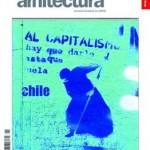What could I tell you after 10 years of work at Arhitectura? The start was truly from zero, a certain type of zero since we had the experience of Virtualia and Octogon reviews. That kind of zero in ’99 was a complete lack of funding or means, but we had ourselves to invest and to spend.
We were somehow born with the very start of Romanian internet and that helped us in being as effective as possible given the minimal costs of organising such an editorial adventure. The first editorial meetings were rather informal, texts were written at home (which was head office at the same time), texts were sent as attachments to yahoo email addresses while dial-up modems were very busy. And sometimes, that is most often, we were on the way to finalise the print in Quarkxpress at dawn. That stage lasted about two years, and culminated with finding a large studio on Banului street where we had three computers and two storage units. We may call it the first office with a telephone where we could be reached after 12 until late in the evening. The review would appear intermittently and had either 64 or 48 pages, in black and white and an undisclosed number of copies. Once out of print, we used to carry the copies in bags to the Union of Architects (and a few bookshops) and architects would get it from there or get it as a present. We kept writing about things around us, small victories of modern architecture in a mass of ugliness around: Radu Teaca’s house on Matei Voievod street, Radu Mihailescu’s Herczeg house, Badea Cartan Square in Timisoara designed by Andreescu Gaivoronschi, Dorin Stefan’s club named Twice; we practically assisted the birth of modern architecture in Romania, and, at the same time, the non-urban chaos industriously coming around.
Once moved on Blanari street, across Club A, in the Bucharest Montmatre as we used to call that Bohemian setting – the great adventure of our editorial and visual identity started. We designed and made up the whole project of Arhitectura review, the logo and the new layout, the format and the style of articles. We are so closely connected to that street: popular faces of Argentin bistro where the beer was probably cheaper than in a shop, nights and mornings of getting texts done (failures and sometimes awards), confirmations, enthusiasm. At night, the red light of an antenna on the Intercontinental could be seen at the window of the fifth floor where we worked, and the noise on Magheru boulevard and the constant hum of beers down at the bistro. Beyond funny issues or critical issues we faced, our top award was we were very close to quality architecture. The selection of materials, our interpreting, theorising, decoding plans, the way we were making up a whole issue were taking us so close to the architecture we referred to that this simply turned into a way to make architecture. We were quite happy to accomplish certain things and could really share it with other architects. I remember that Eugen Panescu from Planwerk – had just met him and were talking into English, though I have no idea why we did that (perhaps his friend, Michael Buck, was there and he could not speak Romanian) – told me speaking about issue no.12, the one in red cover, labelled Latino: “good stuff.” I was quite proud, rather happy that the review reached Cluj and was not only distributed to the Romanian Union of Architects. Latino was a collection of South American and Spanish architects led by Barragan, Bendeta Tagliabue, Daniel Silberfaden, Jordi Merce, Lluis Canosa, Alvaro Rodriguez, with top projects, including a lacustrian school in the waters of Orinoco and the whole plead of that issue was about a clear vision of the profession, no matter what budget, the frail economic background, a kind of moral commitment to matter, the beneficiary, the whole world. I look back now at the way Eugen said “good stuff”, it really fit the essence of the publication: good stuff on the way, a light illegal scent since our printing house was modest and the review seemed to be a manifesto made out in rather hard conditions. Perhaps I felt the same mysterious scent with the Chilean issue, not because of the review itself but because of the cover with a graffiti declaring “fuck capitalism until it hurts.” A nice cover actually since we always wanted to had covers acting as manifestos, be them affirmative, rebellious or defiant, not the plain decorating kind to say to an outsider that Arhitectura is an architectural review. I had no illusions or doubts about who and why reads us. Our message was for the cultivated, the tough, the good, the critical, the demanding, the academic and the connoisseurs.
The third street to mark our life, the place we spread the “good stuff” from constantly had such a funny name that we decided we deserve each other. You know that we all look to coincidences, symmetries and round numbers; well, you need to accept that we had to celebrate 10 years since this adventure started right on 10 tables street. A change, something new under way. Given this round number, we invited the
square cat (a cat of geometrical attributes, knowing Bucharest very well) to say a few things. We come back in autumn, with the same fervour. Enjoy summer!
Translation: Dana Radler


